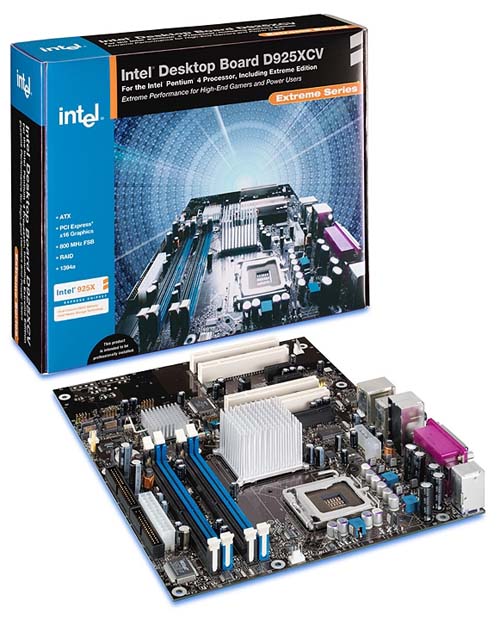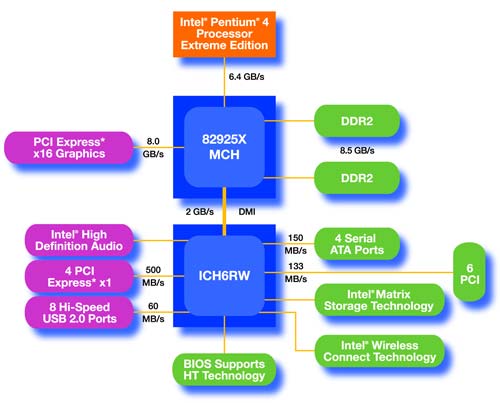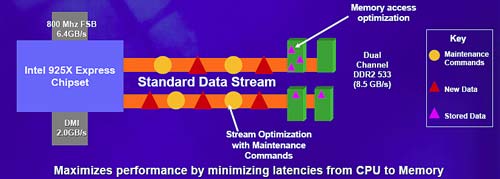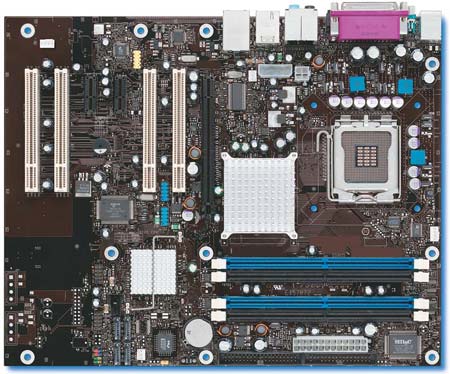Intel 925X/915: Chipset Performance & DDR2
by Wesley Fink on June 19, 2004 3:01 AM EST- Posted in
- CPUs
Intel 925X Express
The Intel D925XCV is the Enthusiast version flagship for all the new Intel technology.
That is not to say Enthusiasts will stand in line to buy the new Intel board, since Intel has not traditionally supported the kinds of features and adjustments that will sway enthusiasts to buy a high-end Intel motherboard. The top Intel motherboard is always, however, a top-performing motherboard at default speeds, and it becomes the chipset performance standard. It is also the standard-bearer for Intel chipset features.
If you look carefully, you will see that the power connectors on the new motherboards, both 925X and 915, are 24-pin, and not the common 20-pin ATX connectors on current Pentium 4 power supplies. We found that server grade power supplies providing 24-pin connectors work fine on the new boards. However, if you have a new top-line PCIe graphics card you will likely find a new 6-pin power connector on the graphics card. You will need either a new power supply with the 6-pin graphics connector or a converter cable that allows two 4-pin molex to be combined in a 6-pin connector to power the new high-end PCIe cards. This is true of both 925X and 915 boards.

925X only supports DDR2 and PCI Express 16X graphics. 925X is also the only 775 chipset version that is stated to support ECC memory. We were not able to verify ECC support, since we did not have access to DDR2 ECC memory. The other features are related to the ICH6 version used with 925X, though you will more likely see ICH6R and ICH6RW (pictured here) paired with 925X.
The other distinguishing feature of Intel 925X is accelerated performance modes compared to 915 chipsets. Intel first differentiated their "Enthusiast" board with enhanced performance on the 875 chipset. The 875 chipset featured PAT, or Performance Acceleration Technology, which was supposed to be a unique feature of the 875 chipset. Chipset manufacturers began revising 865 boards to support PAT-like performance almost as soon as Intel launched 865/875. This was not a development that pleased Intel.

This time around, Intel is also differentiating their top chipset with enhanced performance. Intel did not share any catchy names like PAT, and the diagram above is the only information that they provided on how they make the 925X faster. When we asked for more information than the almost meaningless diagram above, Intel said their acceleration methods were "proprietary". This is not really a surprise after the PAT confusion with 875/865. Industry sources tell us that the new acceleration scheme used on 925X is much more complicated than PAT; it will not likely appear on 915 chipset solutions from other manufacturers.











57 Comments
View All Comments
Neekotin - Saturday, June 19, 2004 - link
guess i'll be keeping my system for another 1 year.. hehehe ;). just gonna buy me a new GPU!Degrador - Saturday, June 19, 2004 - link
Well this has just confirmed my plan for an athlon 64 next - I can't see any reason to be looking towards intel, either now or in the near future (next 6 months).WileCoyote - Saturday, June 19, 2004 - link
baby steps...mkruer - Saturday, June 19, 2004 - link
Actually now that I think of Intel might be correct. The chipset may be up to 15% faster, its just that Prescott is up to 15% slower.wicktron - Saturday, June 19, 2004 - link
zzzzzzmkruer - Saturday, June 19, 2004 - link
The moral of this story, buy AMD instead.Falloutboy525 - Saturday, June 19, 2004 - link
now it makes sence as to why amd isn't even bothering wth ddr2 till it speeds up